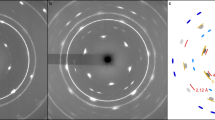Abstract
STRIATIONS perpendicular to the Z-axis frequently occur on prism faces of quartz. They are often attributed to an ‘oscillatory combination’ of the prism and adjacent rhombohedron faces; but although this sometimes undoubtedly occurs (leading to tapered and ‘candle’ crystals), we believe that it is not the correct explanation of striations on well-developed crystals. A study of the surface topography of a number of natural crystals and a few synthetic crystals shows that the striations can be attributed to a difference in the rate of spreading of growth sheets parallel and perpendicular to the Z-axis.
This is a preview of subscription content, access via your institution
Access options
Subscribe to this journal
Receive 51 print issues and online access
$199.00 per year
only $3.90 per issue
Buy this article
- Purchase on Springer Link
- Instant access to full article PDF
Prices may be subject to local taxes which are calculated during checkout
Similar content being viewed by others
References
Seager, A. F., Mineralogical Society, March 8, 1951.
Author information
Authors and Affiliations
Rights and permissions
About this article
Cite this article
VAN PRAAGH, G., WILLIS, B. Striations on Prism Faces of Quartz. Nature 169, 623–624 (1952). https://doi.org/10.1038/169623b0
Issue Date:
DOI: https://doi.org/10.1038/169623b0
Comments
By submitting a comment you agree to abide by our Terms and Community Guidelines. If you find something abusive or that does not comply with our terms or guidelines please flag it as inappropriate.



